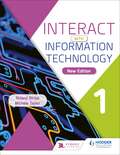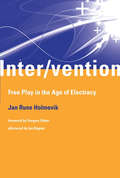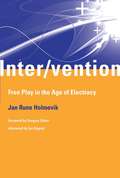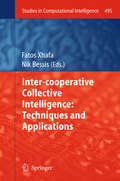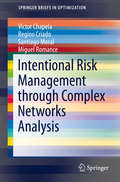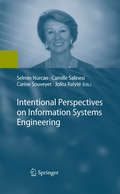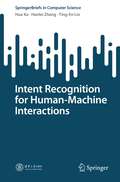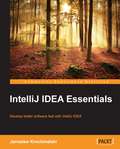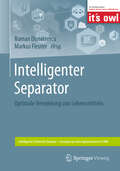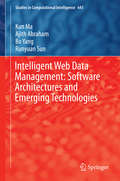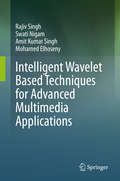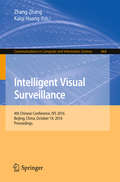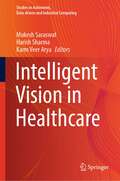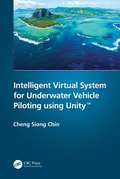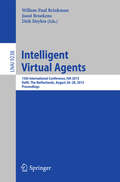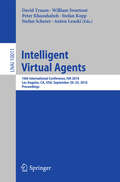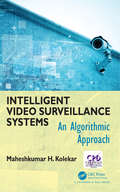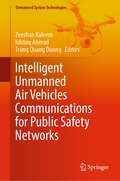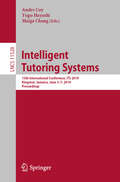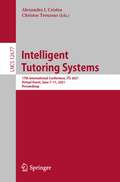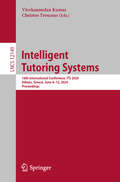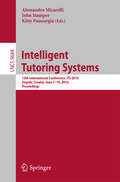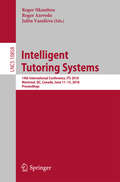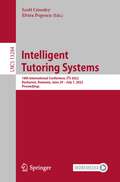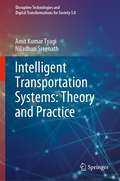- Table View
- List View
Interact with Information Technology 1 new edition
by Roland Birbal Michele TaylorProvide an accessible approach to theory and practice with this new edition updated to comprehensively cover recent IT developments and the latest Caribbean curricula for Forms 1 to 3 (Grades 7 to 9).- Consolidate learning through a range of question types such as Multiple Choice, True or False, Short Answer and a fun Crossword puzzle.- Build critical thinking and project work skills with research and STEM projects using real life situations.- Develop understanding with new topics covered such as computer ethics, algorithm development, emerging careers.The answers can be found here: www.hoddereducation.co.uk/interactanswers
Inter/vention: Free Play in the Age of Electracy
by Jan Rune HolmevikA proposal that electracy—the special skills needed to navigate and understand our digital world—can be developed through play. In today's complex digital world, we must understand new media expressions and digital experiences not simply as more technologically advanced forms of “writing” that can be understood and analyzed as “texts” but as artifacts in their own right that require a unique skill set. Just as agents seeking to express themselves in alphabetic writing need to be literate, “egents” who seek to express themselves in digital media need to be—to use a term coined by cybertheorist Gregory Ulmer—electrate. In Inter/vention, Jan Holmevik helps to invent electracy. He does so by tracing its path across the digital and rhetorical landscape—informatics, hacker heuretics, ethics, pedagogy, virtual space, and monumentality—and by introducing play as a new genre of electracy. Play, he argues, is the electrate ludic transversal. Holmevik contributes to the repertoire of electrate practices in order to understand and demonstrate how play invents electracy.Holmevik's argument straddles two divergences: in rhetoric, between how we study rhetoric as play and how we play rhetorically; and in game studies, between ludology and narratology. Games studies has forged ludology practice by distinguishing it from literate practice (and often allying itself with the scientific tradition). Holmevik is able to link ludology and rhetoric through electracy.Play can and does facilitate invention: play invented the field of ludology. Holmevik proposes a new heuretic in which play acts as a conductor for the invention of electracy. Play is a meta behavior that touches on every aspect of Ulmer's concept of electracy.
Inter/vention
by Jan Rune Jan Rune HolmevikIn today's complex digital world, we must understand new media expressions and digital experiences not simply as more technologically advanced forms of "writing" that can be understood and analyzed as "texts" but as artifacts in their own right that require a unique skill set. Just as agents seeking to express themselves in alphabetic writing need to be literate, "egents" who seek to express themselves in digital media need to be--to use a term coined by cybertheorist Gregory Ulmer-- electrate. In Inter/vention, Jan Holmevik helps to invent electracy. He does so by tracing its path across the digital and rhetorical landscape--informatics, hacker heuretics, ethics, pedagogy, virtual space, and monumentality--and by introducing play as a new genre of electracy. Play, he argues, is the electrate ludic transversal. Holmevik contributes to the repertoire of electrate practices in order to understand and demonstrate how play invents electracy. Holmevik's argument straddles two divergences: in rhetoric, between how we study rhetoric as play and how we play rhetorically; and in game studies, between ludology and narratology. Games studies has forged ludology practice by distinguishing it from literate practice (and often allying itself with the scientific tradition). Holmevik is able to link ludology and rhetoric through electracy. Play can and does facilitate invention: play invented the field of ludology. Holmevik proposes a new heuretic in which play acts as a conductor for the invention of electracy. Play is a meta behavior that touches on every aspect of Ulmer's concept of electracy.
Inter-cooperative Collective Intelligence: Techniques and Applications
by Nik Bessis Fatos XhafaThis book covers the latest advances in the rapid growing field of inter-cooperative collective intelligence aiming the integration and cooperation of various computational resources, networks and intelligent processing paradigms to collectively build intelligence and advanced decision support and interfaces for end-users. The book brings a comprehensive view of the state-of-the-art in the field of integration of sensor networks, IoT and Cloud computing, massive and intelligent querying and processing of data. As a result, the book presents lessons learned so far and identifies new research issues, challenges and opportunities for further research and development agendas. Emerging areas of applications are also identified and usefulness of inter-cooperative collective intelligence is envisaged. Researchers, software developers, practitioners and students interested in the field of inter-cooperative collective intelligence will find the comprehensive coverage of this book useful for their research, academic, development and practice activity.
Intentional Risk Management through Complex Networks Analysis
by Victor Chapela Regino Criado Santiago Moral Miguel RomanceThis book combines game theory and complex networks to examine intentional technological risk through modeling. As information security risks are in constant evolution, the methodologies and tools to manage them must evolve to an ever-changing environment. A formal global methodology is explained in this book, which is able to analyze risks in cyber security based on complex network models and ideas extracted from the Nash equilibrium. A risk management methodology for IT critical infrastructures is introduced which provides guidance and analysis on decision making models and real situations. This model manages the risk of succumbing to a digital attack and assesses an attack from the following three variables: income obtained, expense needed to carry out an attack, and the potential consequences for an attack. Graduate students and researchers interested in cyber security, complex network applications and intentional risk will find this book useful as it is filled with a number of models, methodologies and innovative examples.
Intentional Perspectives on Information Systems Engineering
by Selmin Nurcan Jolita Ralyté Carine Souveyet Camille SalinesiRequirements engineering has since long acknowledged the importance of the notion that system requirements are stakeholder goals--rather than system functions--and ought to be elicited, modeled and analyzed accordingly. In this book, Nurcan and her co-editors collected twenty contributions from leading researchers in requirements engineering with the intention to comprehensively present an overview of the different perspectives that exist today, in 2010, on the concept of intention in the information systems community. These original papers honor Colette Rolland for her contributions to this field, as she was probably the first to emphasize that 'intention' has to be considered as a first-class concept in information systems engineering. Written by long-term collaborators (and most often friends) of Colette Rolland, this volume covers topics like goal-oriented requirements engineering, model-driven development, method engineering, and enterprise modeling. As such, it is a tour d'horizon of Colette Rolland's lifework, and is presented to her on the occasion of her retirement at CaISE 2010 in Hammamet, the conference she once cofounded and which she helped to grow and prosper for more than 20 years.
Intent Recognition for Human-Machine Interactions (SpringerBriefs in Computer Science)
by Hua Xu Hanlei Zhang Ting-En LinNatural interaction is one of the hottest research issues in human-computer interaction. At present, there is an urgent need for intelligent devices (service robots, virtual humans, etc.) to be able to understand intentions in an interactive dialogue. Focusing on human-computer understanding based on deep learning methods, the book systematically introduces readers to intention recognition, unknown intention detection, and new intention discovery in human-computer dialogue. This book is the first to present interactive dialogue intention analysis in the context of natural interaction. In addition to helping readers master the key technologies and concepts of human-machine dialogue intention analysis and catch up on the latest advances, it includes valuable references for further research.
IntelliJ IDEA Essentials
by Jaroslaw KrochmalskiThis book is for developers who want to work smarter so they can focus their efforts on the details that will give them the advantage. This book is tailor-made for developers who want to move from NetBeans and Eclipse to experience the power and functionality of IntelliJ IDEA.
Intelligenter Separator: Optimale Veredelung von Lebensmitteln (Intelligente Technische Systeme – Lösungen aus dem Spitzencluster it’s OWL)
by Roman Dumitrescu Markus FleuterDas Buch beinhaltet die Ergebnisse des dreijährigen Verbundprojekts "Separator i4.0" des BMBF-Spitzenclusters it's OWL. Gegenstand des Projekts war die nachhaltige Einbindung von Expertenwissen in die zukunftsweisende Weiterentwicklung und Optimierung von Separationsprozessen. Durch die Entwicklung neuartiger intelligenter Komponenten aus dem Bereich der Sensorik wird es zukünftig möglich sein, Separatoren und die zugehörigen Prozesszusammenhänge zu verstehen und diese ökologisch/ökonomisch optimal auszulegen und zu betreiben. Hierzu wurde ein Instrumentarium bestehend aus Methoden und Lösungen erarbeitet, das darüber hinaus auf analoge Problemstellungen komplexer maschinenbaulicher Anlagen anwendbar sein wird.
Intelligent Web Data Management: Software Architectures and Emerging Technologies
by Kun Ma Ajith Abraham Bo Yang Runyuan SunThis bookpresents some of the emerging techniques and technologies used to handle Webdata management. Authors present novel software architectures and emergingtechnologies and then validate using experimental data and real world applications. The contents of this book are focused on four popular thematic categories ofintelligent Web data management: cloud computing, social networking, monitoringand literature management. The Volume will be a valuable reference toresearchers, students and practitioners in the field of Web data management,cloud computing, social networks using advanced intelligence tools.
Intelligent Wavelet Based Techniques for Advanced Multimedia Applications
by Amit Kumar Singh Mohamed Elhoseny Rajiv Singh Swati NigamThis book contains high-quality research articles and reviews that promote research and reflect the most recent advances in intelligent wavelet based techniques for advanced multimedia applications as well as other emerging areas. In recent time, wavelet transforms have become useful in many signal, image and video processing applications, especially for multimedia security and surveillance. A few applications of wavelets in security and surveillance are watermarking, fusion, steganography, object detection, tracking, motion recognition and intention recognition, etc. Wavelets are well capable of analyzing signal, image and video at different resolution levels, popularly known as multiresolution analysis. The multiresolution analysis is advantageous in multimedia security and surveillance applications. It provides flexibility in selection of different resolution levels that leads to better accuracy. Furthermore, recently sparse representation has become an advancement to analyze wavelet coefficients. It is observed that wavelet transforms possess the invariance property which makes them suitable for many vision applications. This book provides a concise overview of the current state of the art and disseminates some of the novel and exciting ideas and techniques. In addition, it is also helpful for the senior undergraduate and graduate students, researcher, academicians, IT professional and providers, citizens, customers as well as policy makers working in this area as well as other emerging applications demanding state-of-the-art wavelet based multimedia applications.
Intelligent Visual Surveillance
by Zhang Zhang Kaiqi HuangThis book constitutes the refereed proceedings of the 4th Chinese Conference, IVS 2016, held in Beijing, China, in October 2016. The 19 revised full papers presented were carefully reviewed and selected from 45 submissions. The papers are organized in topical sections on low-level preprocessing, surveillance systems; tracking, robotics; identification, detection, recognition; behavior, activities, crowd analysis.
Intelligent Vision in Healthcare (Studies in Autonomic, Data-driven and Industrial Computing)
by Karm Veer Arya Harish Sharma Mukesh SaraswatThis book focuses on various aspects of computer vision applications in the field of healthcare. It covers new tools and technologies in some of the important areas of medical science like histopathological image analysis, cancer taxonomy, use of deep learning architecture dental care, and many more. Furthermore, this book reviews and discusses the use of intelligent learning-based algorithms for increasing the precision in medical domain. The book discusses different computer vision algorithms which are useful in various industries and day-to-day life. It also highlights many challenges faced by research community, like view point variations, scale variations, illumination variations, multi-modalities, and noise.
Intelligent Virtual System for Underwater Vehicle Piloting using Unity™
by Cheng Siong ChinThis book supports readers in the development of a remotely operated vehicle (ROV) pilot training simulator by exploiting open-source or free gaming software and emphasizing the importance of using established and widely-available game design techniques to provide engaging scenarios for ROV training developers and trainees. There is no such book to guide the users to create an open-source virtual simulator for pilot training in the marine and offshore industry. This book can be used as a reference for undergraduate and postgraduate students, engineers, researchers, and lecturers in VR simulation using UnityTM as the leading software. Some of the key features of the book include: • Step-by-step procedures in development ROV pilot training simulator • Use of open-source software UnityTM that is freely available to all readers • The codes used in the book are self-sufficient as there are no codes hidden from readers
Intelligent Virtual Agents
by Willem-Paul Brinkman Joost Broekens Dirk HeylenThis book constitutes the proceedings of the 15th International Conference on Intelligent Virtual Agents, IVA 2015, held in Delft, The Netherlands, in August 2015. The 11 full papers, 22 short papers, and 21 demo and poster papers accepted were carefully reviewed and selected from 70 submissions. Constructing and studying intelligent virtual agents requires knowledge , theories, methods, and tools from a wide range of fields such as computer science, psychology, cognitive sciences, communication, linguistics, interactive media, human-computer interaction, and artificial intelligence. The papers are organized in topical sections such as adaptive dialogue and user modeling; cognitive, affective and social models; nonverbal behavior and gestures; pedagogical agents in health and training; tools and frameworks; turn-taking; virtual agent perception studies.
Intelligent Virtual Agents
by David Traum William Swartout Peter Khooshabeh Stefan Kopp Stefan Scherer Anton LeuskiThis book constitutes the proceedings of the 16th International Conference on Intelligent Virtual Agents, IVA 2016, held in Los Angeles, CA, USA, in September 2016. The 12 full papers, 18 short papers, and 37 demo and poster papers accepted were carefully reviewed and selected from 81 submissions. IVA 2016 also includes three workshops: Workshop on Chatbots and Conversational Agents (WOCHAT), Can you feel me now? Creating Physiologically Aware Virtual Agents (PAVA), and Graphical and Robotic Embodied Agents for Therapeutic Systems, GREATS16. Intelligent Virtual Aspects (IVAs) are intelligent digital interactive characters that can communicate with humans and other agents using natural human modalities such as facial expressions, speech, gestures, and movement. They are capable of real-time perception, cognition, emotion and action that allow them to participate in dynamic social environments. Constructing and studying IVAs requires tools from a wide range of fields such as computer science, psychology, cognitive science, communication, linguistics, interactive media, human-computer interaction and artificial intelligence.
Intelligent Video Surveillance Systems: An Algorithmic Approach
by Maheshkumar H KolekarThis book will provide an overview of techniques for visual monitoring including video surveillance and human activity understanding. It will present the basic techniques of processing video from static cameras, starting with object detection and tracking. The author will introduce further video analytic modules including face detection, trajectory analysis and object classification. Examining system design and specific problems in visual surveillance, such as the use of multiple cameras and moving cameras, the author will elaborate on privacy issues focusing on approaches where automatic processing can help protect privacy.
Intelligent Unmanned Air Vehicles Communications for Public Safety Networks (Unmanned System Technologies)
by Zeeshan Kaleem Ishtiaq Ahmad Trung Quang DuongThis book provides a comprehensive overview of the potential use cases and intelligent technologies, UAV layered architectures, research findings, experimental results, and standardization for intelligent UAV communications for public safety networks. This book will cover the conventional non-intelligent and intelligent solutions specifically targeting UAV communications for public safety networks. Moreover, reconfigurable intelligent surface (RIS) has recently attracted researchers and academician attention because its ability improves the propagation environment and enhances communication quality by intelligently reflecting the received signals. Leveraging intelligence into RIS-assisted UAV communications will meet the requirements of the intelligent, green, and sustainable 5G and beyond cellular networks, which makes it a potential candidate to overcome the inherent drawbacks of legacy wireless systems.The topics covered in this book will be of interest to both the professionals and students. 3D UAV placements schemes, trajectory design, interference management schemes, reinforcement learning solutions for more intelligent and trained solutions, joint UAV trajectory and RIS's passive beamforming design, and various other related topics of readers' interest are presented in detail.
Intelligent Tutoring Systems: 15th International Conference, ITS 2019, Kingston, Jamaica, June 3–7, 2019, Proceedings (Lecture Notes in Computer Science #11528)
by Andre Coy Yugo Hayashi Maiga ChangThis book constitutes the proceedings of the 15th International Conference on Intelligent Tutoring Systems, ITS 2019, held in Kingston, Jamaica, in June 2019. The 14 full papers and 13 short papers presented in this volume were carefully reviewed and selected from 42 submissions. In the back matter of the volume 4 poster papers are included. They deal with the use of advanced computer technologies and interdisciplinary research for enabling, supporting, and enhancing human learning.
Intelligent Tutoring Systems: 17th International Conference, ITS 2021, Virtual Event, June 7–11, 2021, Proceedings (Lecture Notes in Computer Science #12677)
by Alexandra I. Cristea Christos TroussasThis volume constitutes the proceedings of the 17th International Conference on Intelligent Tutoring Systems, ITS 2021, held in Athens, Greece, in June 2021. Due to COVID-19 pandemic the conference was held virtually. The 22 full papers, 22 short papers and 18 other papers presented in this volume were carefully reviewed and selected from 87 submissions. Conforming to the current move of education, work and leisure online, the title of ITS 2021 was “Intelligent Tutoring Systems in an online world”. Its objective was to present academic and research achievements of computer and cognitive sciences, artificial intelligence, and, due to its recent emergence, specifically, deep learning in tutoring and education
Intelligent Tutoring Systems: 16th International Conference, ITS 2020, Athens, Greece, June 8–12, 2020, Proceedings (Lecture Notes in Computer Science #12149)
by Vivekanandan Kumar Christos TroussasThis volume constitutes the proceedings of the 16th International Conference on Intelligent Tutoring Systems, ITS 2020, held in Athens, Greece, in June 2020. The 23 full papers and 31 short papers presented in this volume were carefully reviewed and selected from 85 submissions. They reflect a variety of new techniques, including multimodal affective computing, explainable AI, mixed-compensation multidimensional item response, ensemble deep learning, cohesion network analysis, spiral of silence, conversational agent, semantic web, computer-supported collaborative learning, and social network analysis.
Intelligent Tutoring Systems
by Alessandro Micarelli John Stamper Kitty PanourgiaThis book constitutes the refereed proceedings of the 13th International Conference on Intelligent Tutoring Systems, ITS 2016, held in Zagreb, Croatia, in June 2016. The 20 revised full papers, 32 short papers, 35 posters, and 7 young researchers' track papers presented in this volume were carefully reviewed and selected from 147 submissions. The specific theme of the ITS 2016 conference is "Adaptive Learning in Real World Contexts". ITS 2016 covers a wide range of topics such as: intelligent tutoring; informal learning environments, learning as a side effect of interactions; collaborative and group learning, communities of practice and social networks; simulation-based learning and serious games; dialogue and discourse during learning interactions; co-adaptation between technologies and human learning; ubiquitous and mobile learning environments; empirical studies of learning with technologies, understanding human learning on the web; adaptive support for learning, models of learners, diagnosis and feedback; modeling of motivation, metacognition, and affect aspects of learning; recommender systems for learning; virtual pedagogical agents and learning companions; ontological modeling, semantic web technologies and standards for learning; multi-agent and service oriented architectures for learning and tutoring environments; educational exploitation of data mining and machine learning techniques; instructional design principles or design patterns for educational environments; authoring tools and development methodologies for advanced learning technologies; domain-specific learning technologies, e. g. language, mathematics, reading, science, medicine, military, and industry; non conventional interactions between artificial intelligence and human learning; and privacy and security in e-learning environments.
Intelligent Tutoring Systems: 14th International Conference, ITS 2018, Montreal, QC, Canada, June 11–15, 2018, Proceedings (Lecture Notes in Computer Science #10858)
by Roger Nkambou Roger Azevedo Julita VassilevaThis book constitutes the proceedings of the 14th International Conference on Intelligent Tutoring Systems, IST 2018, held in Montreal, Canada, in June 2018.The 26 full papers and 22 short papers presented in this volume were carefully reviewed and selected from 120 submissions. In the back matter of the volume 20 poster papers and 6 doctoral consortium papers are included. They deal with the use of advanced computer technologies and interdisciplinary research for enabling, supporting and enhancing human learning.
Intelligent Tutoring Systems: 18th International Conference, ITS 2022, Bucharest, Romania, June 29 – July 1, 2022, Proceedings (Lecture Notes in Computer Science #13284)
by Elvira Popescu Scott CrossleyThis volume constitutes the proceedings of the 18th International Conference on Intelligent Tutoring Systems, ITS 2022, held in Bucharest, Romania, in June 2022. The 14 full papers, 13 short papers and 11 poster papers presented in this volume were carefully reviewed and selected from 50 submissions. The papers are categorized into the following topical sib-headings: Tools and Methods for learning Sciences and Practices; Algorithms for Prediction, Recommendation and Classification in Learning Systems; Tutoring and Learning Systems: New Approaches, Framework and Theories.
Intelligent Transportation Systems: Theory and Practice (Disruptive Technologies and Digital Transformations for Society 5.0)
by Amit Kumar Tyagi Niladhuri SreenathThis book provides fundamental principles of intelligent transport systems with comprehensive insight and state of the art of vehicles, vehicular technology, connecting vehicles, and intelligent vehicles/autonomous intelligent vehicles. The book discusses different approaches for multiple sensor-based multiple-objects tracking, in addition to blockchain-based solutions for building tamper-proof sensing devices. It introduces various algorithms for security, privacy, and trust for intelligent vehicles. This book countermeasures all the drawbacks and provides useful information to students, researchers, and scientific communities. It contains chapters from national and international experts and will be essential for researchers and advanced students from academia, and industry experts who are working on intelligent transportation systems.
